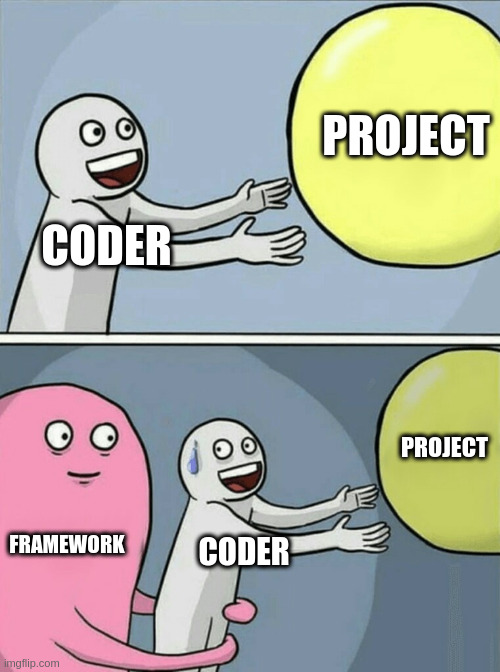Framework noun
/ˈfreɪm.wɝːk/
a supporting structure around which something can be built
– Definition by Cambridge Dictionary
Ever since the advent of JavaScript in the mid-90’s, developers have been struggling to find a solution for creating reusable code that can be easily be implemented in different projects.
Originally, frameworks were meant to address this problem by providing developers with more control over how their applications would run.
This was achieved in a number of ways including putting all code that is meant for re-use into a self-contained entity known as framework.

This idea of re-usable frameworks ultimately turned into libraries.
Depending on who you ask, the line between libraries and frameworks may seem blurred, but there are some key differences that need to be addressed.
We will dive into this aspect in a bit.
Let’s start with one important question.
What are JavaScript Frameworks used for?
If you don’t live under a rock, you might have noticed that JavaScript frameworks are extremely popular nowadays.
Source: Github - Front End Frameworks Popularity
There is hardly an aspiring web developer who hasn’t heard about some of the most popular JavaScript Frameworks like React and Angular.
So you are rightfully thinking what’s all the fuzz about?
Let’s start at the beginning.
One of the most misunderstood areas of Web Development is JavaScript.
When it was first introduced in 1995, it was considered as more of a toy than an essential development tool.
But that changed with the emergence of JavaScript frameworks and libraries.
These days, many prominent website uses JavaScript in one form or another.
Before hopping onto one of the frameworks you might want to answer the next question for yourself first.
Do I need a JavaScript Framework?
No.
Yes.
Maybe.
Wait a sec.
🤨
Let me explain.
JavaScript Frameworks are a good way of speeding up your development process and creating efficient code.
This leads to a reduction of development, debugging and testing time.
In theory you do not need any Framework to develop.
A lot can be achieved by plain Vanilla JavaScript.
Check out this Weather App created in vanilla JavaScript
So when it comes to creating your own projects you can choose how you want to handle things.
Looking over to the professional world of coding you will notice that nearly all Web Development job listings require some kind of Framework.
If your goal is to land a job you will not be able to steer around learning a popular JavaScript Framework.
Why are JavaScript Frameworks useful?
Well, as you know time = money.
So, more time = more money.
This means fast time to lambo.
As mentioned, Frameworks speed up the whole chain of development and thereby save you a lot of time.
Using the right JavaScript framework can make it easier to develop more interactive, dynamic web applications.
There are plenty of JavaScript frameworks to choose from, each with different features.
In addition JavaScript Frameworks can be learned rather quickly.
Since a JavaScript Framework is just a library of code that helps you work with existing web development standards, such as HTML5 and CSS3, it should not conflict with the basic coding practices you already know.
This means you can use a framework without having to learn complicated new processes or languages.
What is the difference between Libraries and Frameworks?
Here’s a quick and easy to understand explanation
A library performs specific, well-defined operations.
A framework is a skeleton where the application defines the “meat” of the operation by filling out the skeleton. The skeleton still has code to link up the parts but the most important work is done by the application.
Source: Stackoverflow
That’s enough for now and to understand the next aspect.
What are examples of JavaScript Frameworks?
Popular Front-End Frameworks are
Angular is a JavaScript framework that makes it easy to build web applications.
Its goal is to augment browser-based applications with model–view–controller (MVC) capability, in an effort to make both development and testing easier.
Angular can be used in combination with other frameworks like React, Vue, Ember, or even jQuery.
React (also known as React.js or ReactJS) is a JavaScript library for building user interfaces.
It is maintained by Facebook and a community of individual developers and companies.
React can be used as a base in the development of single-page or mobile applications.
Complex React applications usually require the use of additional libraries for state management, routing, and interaction with an API.
Vue.js is one of the latest players in the front-end frameworks scene.
Vue.js is a framework for building user interfaces. It’s very simple, flexible, and easy-to-use, similar to jQuery and Bootstrap.
Now that you have learned about some JavaScript Frameworks you might think:
How many JavaScript Frameworks are there?
According to Wikipedia about 83 whereby some are not maintained any more.
Final thoughts
The goal of this article was to give a brief overview of what JavaScript frameworks are and when you can use them.
I also wanted to clear up some vocabulary terms that get confused between frameworks and libraries.
Hopefully, after reading this article you’ll have a better understanding of what JavaScript Frameworks are, why you might use one, and how to choose the right framework for your particular use case.
Before I jump off I would like to know one thing.
Have you ever worked with a JavaScript Framework?
Just tweet me
futurefounder21.